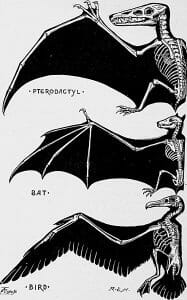Over the eons of evolutionary time, organisms have differentiated themselves in recognizable patterns. Two of these patterns are known as convergent and divergent evolution. Both show the ways that organisms have responded to natural selection and provide evidence for the theory of evolution.
Convergent Evolution
Convergent evolution is seen in how distinct species have evolved similar traits in response to a similar environment or pressure due to natural selection. An example of this is the streamlined, bullet-type shape of sharks and dolphins that allows them to swim fast through the water. However, sharks are fish and dolphins are mammals and they are very far apart on the evolutionary tree. Because organisms that do not have a common ancestor can evolve in the same ways is powerful evidence for natural selection.

The image above is from the 1892 book by John Romanes, Darwin and After Darwin: Volume 1, The Darwinian Theory: An Exposition of the Darwinian Theory and Discussion of Post-Darwinian Questions. The drawing shows the similarities in the wing structure of three distinct species created through convergent evolution.
Divergent Evolution
As the name implies, divergent evolution shows how species can change slightly over time and separate (diverge) into new forms. For example, in vertebrates like pigs, birds, monkeys and whales, the forelimbs have the same general sets of bones, but they have been modified over time so the animals can use their forelimbs in very different ways. Divergent evolution is studied on a larger scale such as how the current diversity of life on Earth evolved from the first living cells, to a smaller scale where natural selection caused humans and apes to evolve from a common ancestor.

The image above shows how the beak sizes and shapes of finches that live on the Galapagos Islands (Darwin’s Finches) have diverged over time in response to natural selection pressures from the competition for food.
Differences Between Convergent and Divergent Evolution
Three main differences between convergent and divergent evolution are:
- Convergent evolution shows how species have evolved separately but have similar (analogous) structures. Divergent evolution demonstrates how species can have common (homologous) anatomical structures which have evolved for different purposes.
- Convergent evolution happens in organisms that are not closely related while divergent evolution is observed in organisms that are closely related.
- The relationship between the analogous structures in different species that evolved through convergent evolution can be less distinct compared to the homologous structures seen in divergent evolution which have the same basic structural plan.
References
- Convergent and Divergent Evolution. (n.d.). Retrieved October 4, 2017, from https://online.science.psu.edu/bisc002_activeup001/node/9997
- Patterns of Evolution. (n.d.). Retrieved October 4, 2017, from http://www.sparknotes.com/biology/evolution/patternsofevolution/section1.rhtml
